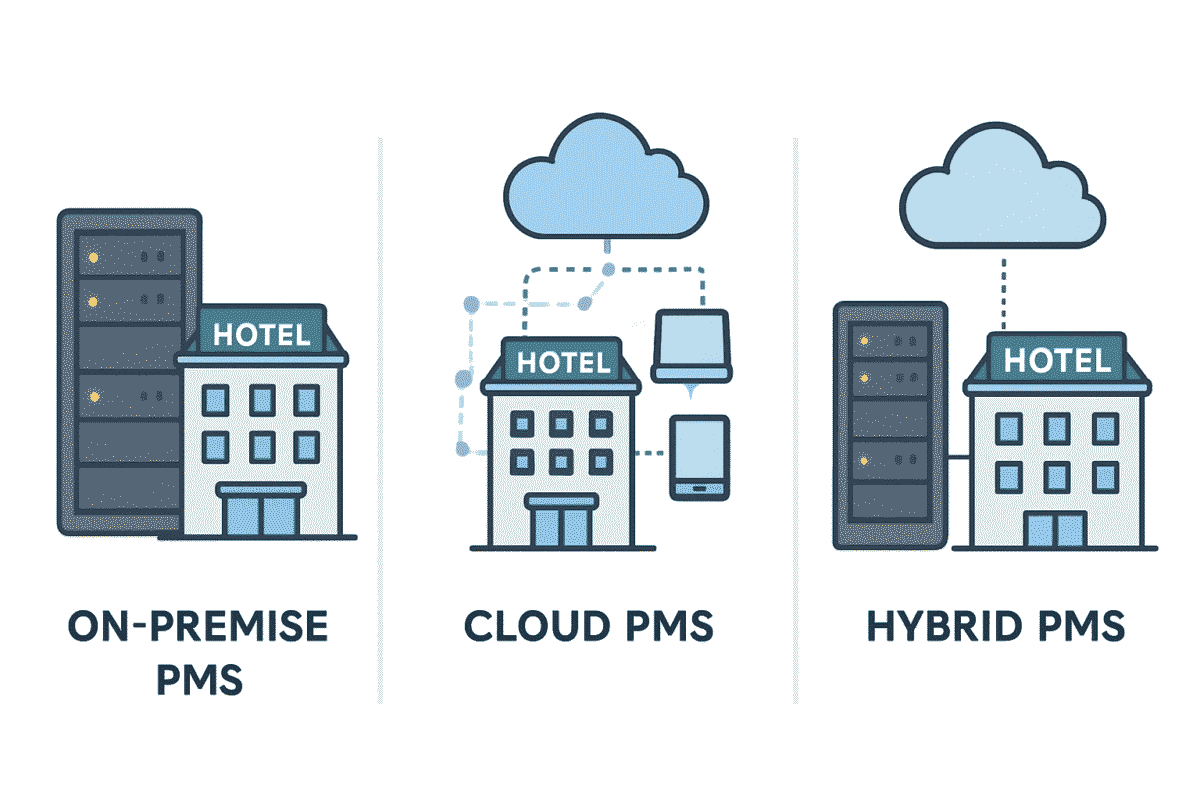The main difference with types of PMS software lies on how it’s deployed. Understanding these types is very important.

Main Three Types of PMS Software
1. On-Premise Hotel PMS
What it is: An on-premise PMS is installed directly on the hotel’s physical servers and computers. This means the hotel owns and maintains the hardware and software licenses (At the time of this writing, this type of PMS is fast becoming obsolete among the small and mid-sized hotels as PMS of their choice).
Key Features:
- Local Data Storage: All data is stored on the hotel’s own servers, offering direct control over data security.
- One-Time License Fee (Not always): Often involves a larger upfront investment for software licenses and hardware.
- Offline Functionality: Can operate without a constant internet connection, making it suitable for areas with poor internet connectivity.
Pros:
- Full Control: Hotels have complete control over their data and infrastructure.
- Downtime: Whenever a downtime is needed for maintenance, hotel management can decide the best dates/time as per their operation.
- Customization Potential: Potentially more scope for deep customization to specific operational needs.
- No Reliance on Internet: Unaffected by internet outages once installed.
Cons:
- High Upfront Costs: Significant initial investment in hardware, software licenses, and installation.
- Maintenance Burden: Requires an in-house IT team or external support for maintenance, updates, and troubleshooting.
- Limited Scalability: Scaling up (e.g., adding more rooms or properties) often requires significant additional hardware investment and can be complex.
- Slower Updates: Updates typically involve manual installation on each machine, potentially leading to downtime.
- Security Responsibility: The hotel is solely responsible for data security, backups, and disaster recovery.
Examples: Oracle Opera PMS, Infor HMS (Two industry leaders according to IDC MarketScape Worldwide Hospitality Property Management Systems Vendor Assessment)
Ideal For: Larger hotel chains or properties with dedicated IT infrastructure and a preference for maximum control over their data. However, the trend is steadily moving away from on-premise solutions.
2. Cloud-Based Hotel PMS (SaaS — Software as a Service)
What it is: A cloud-based PMS is hosted entirely online by the software vendor and accessed via a web browser or mobile app. It operates on a subscription model, eliminating the need for hotels to manage hardware or software. The cloud segment commanded approximately 80% of the market share in 2024, demonstrating its dominance (Mordor Intelligence).
Key Features:
- Remote Accessibility: Access the system from anywhere, at any time, on any device with an internet connection.
- Subscription Model: Typically involves lower upfront costs and recurring monthly or annual fees.
- Automatic Updates & Maintenance: The vendor handles all software updates, security patches, and server maintenance.
- Real-time Data: Provides real-time insights into occupancy, revenue, and operational performance.
- Open APIs & Integrations: Designed for seamless integration with a wide array of third-party hospitality solutions (channel managers, booking engines, POS, CRM, etc.).
Pros:
- Lower Upfront Costs: Eliminates large capital expenditures on hardware and licenses.
- Scalability: Easily scalable to accommodate growth (e.g., adding rooms, properties, or users) without significant infrastructure changes.
- Enhanced Accessibility: Enables remote management for staff and offers mobile functionalities.
- Automatic Updates: Always run on the latest version of the software with new features and security enhancements.
- Reduced IT Burden: No need for an in-house IT team for PMS maintenance.
- Robust Security & Backups: Vendors typically employ advanced security measures, data encryption, and regular backups in multiple data centers.
Cons:
- Internet Dependency: Requires a stable internet connection to function.
- Data Control: Data is stored externally by the vendor, which may be a concern for some properties (though reputable vendors offer robust security).
- Subscription Costs: Ongoing recurring fees can accumulate over time.
Examples: Oracle Opera Cloud, Cloudbeds
Ideal For: The vast majority of hotels in 2025, from independent boutiques to growing chains, due to its flexibility, scalability, and cost-efficiency. Cloud-based PMS solutions are quickly becoming the industry standard.
3. Hybrid Cloud Hotel PMS
What it is: A hybrid cloud PMS combines elements of both on-premise and cloud-based systems. Some functionalities or data might be hosted locally, while others reside in the cloud. In some cases, a product is described as hybrid since it can be implemented on cloud (hosted data centres) or on-premise with local servers.
Key Features:
- Flexible Deployment: Allows hotels to choose which functions or data are stored locally and which are in the cloud.
- Web Front-End: Often features a web-based interface for accessibility, even if some backend components are on-premise.
Pros:
- Blended Benefits: Aims to offer the control of on-premise with some of the accessibility and scalability of the cloud.
- Transitional Solution: Can be suitable for hotels gradually migrating from an older on-premise system to a fully cloud-based one.
Cons:
- Complexity: Can be more complex to manage and integrate due to the mixed environment.
- Potential for Silos: If not implemented carefully, could lead to data silos between on-premise and cloud components.
- Less Common: As cloud-native solutions become more sophisticated, pure hybrid models are becoming less prevalent.
Examples: Opera PMS V5, Soraso, Infor HMS
Ideal For: Hotels with specific regulatory requirements for local data storage or those in a transitional phase of technology adoption.

